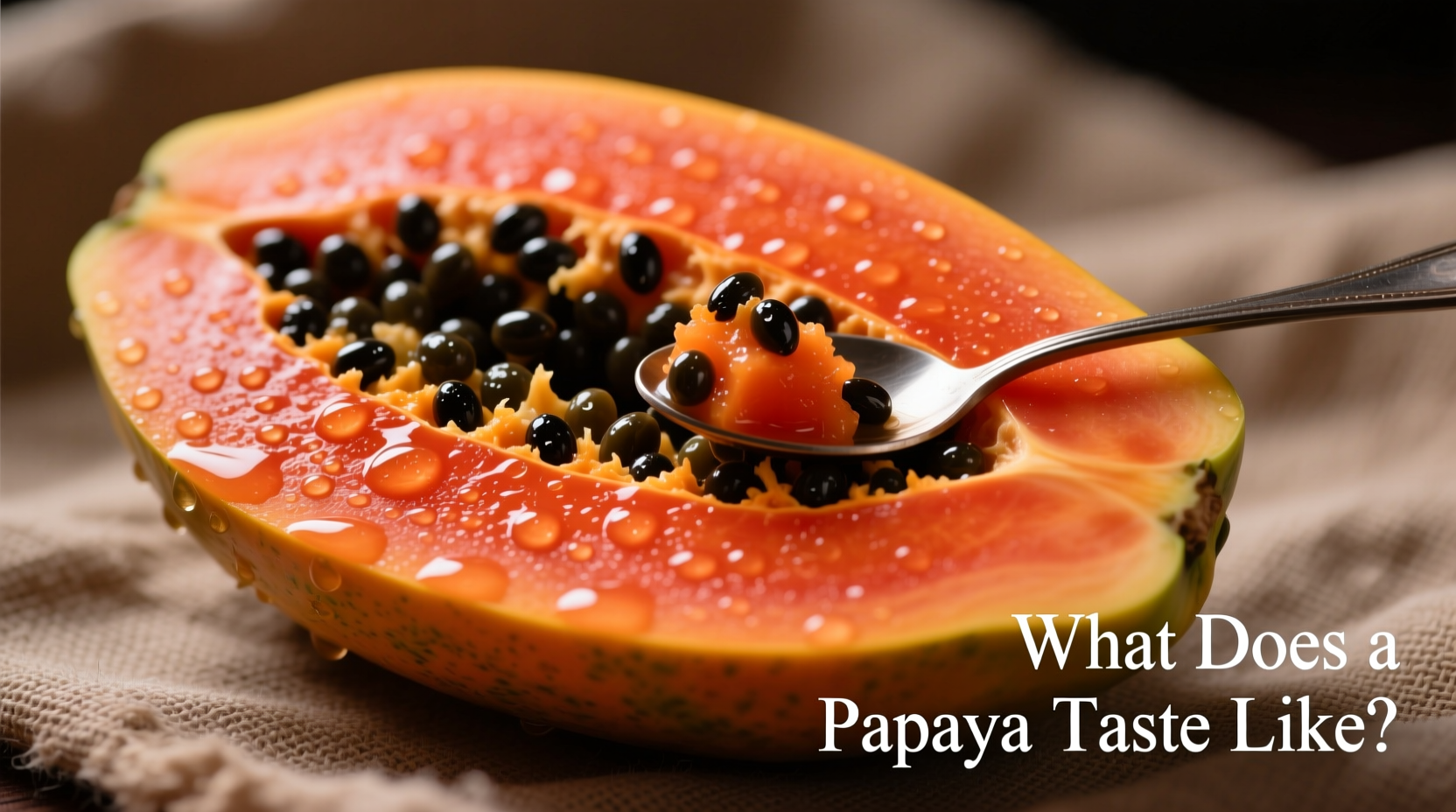Understanding Papaya Ripeness and Its Impact on Flavor
When you're wondering what does a papaya taste like, the most crucial factor is ripeness. This single element transforms papaya from a virtually flavorless vegetable to a sweet tropical delight. As papaya ripens, its starch converts to sugar, developing that characteristic tropical sweetness.
According to agricultural research from the University of Hawaii's College of Tropical Agriculture and Human Resources, papaya undergoes dramatic chemical changes during ripening. The fruit's sugar content can increase from 3-4% in unripe fruit to 10-15% in fully ripe papaya, directly impacting its sweetness profile.
Here's how to determine ripeness and what to expect flavor-wise:
| Ripeness Stage | Visual Cues | Taste Profile |
|---|---|---|
| Unripe (Green) | Firm, completely green skin | Mild, slightly vegetal, similar to cucumber or zucchini |
| Transitioning | Yellow streaks appearing | Slightly sweet with subtle tropical notes |
| Ripe | 75-100% yellow/orange skin | Sweet with mango-cantaloupe notes, floral undertones |
Breaking Down the Papaya Flavor Experience
When exploring what ripe papaya tastes like, you'll notice several distinct flavor components that create its unique profile:
Sweetness Level: Ripe papaya typically registers between 10-15° Brix (a sugar measurement scale), placing it in the moderately sweet category—less sweet than mango but sweeter than cantaloupe. The sweetness is clean and not cloying, with subtle floral undertones.
Aroma Profile: The scent is equally important to the overall experience. A 2023 study published in the Journal of Food Science identified over 30 volatile compounds in ripe papaya, with the most prominent being esters that create that characteristic tropical fragrance.
Texture Component: Unlike many fruits, papaya's texture significantly influences its taste perception. The soft, buttery flesh with tiny edible seeds creates a unique mouthfeel that enhances the sweet flavor. Overly ripe papaya becomes mushy and develops fermented notes, while perfectly ripe fruit maintains a delicate firmness.

Regional Varieties and Their Distinct Flavor Profiles
If you've ever wondered why does papaya taste different sometimes, the answer lies in variety and growing conditions. Just as wine grapes develop terroir, papaya's flavor is influenced by climate, soil, and specific cultivar.
Hawaiian Varieties (Solo, Sunrise): These smaller, pear-shaped papayas deliver consistent sweetness with straightforward tropical notes. The USDA Agricultural Research Service notes that Hawaiian papayas contain higher concentrations of lycopene, which contributes to their vibrant color and slightly different flavor profile compared to other varieties.
Mexican Varieties (Maradol, Tainung): Larger fruits with yellow to orange-red flesh offer more complex flavor notes. Many Latin American culinary experts, including those at Mexico's National Institute of Forestry, Agricultural and Livestock Research, describe Mexican papayas as having subtle berry-like undertones alongside the classic tropical sweetness.
Caribbean Varieties: Often featuring vibrant pink or red flesh, these papayas tend to be the sweetest with pronounced floral notes. The warm Caribbean climate accelerates sugar development while maintaining acidity balance.
Practical Guidance: Selecting and Preparing for Optimal Flavor
Now that you know what a papaya tastes like when ripe, here's how to ensure you get the best flavor experience:
Selection Tips: Look for papayas with 50-75% yellow coloration that yield slightly to gentle pressure. Avoid fruits with excessive bruising or soft spots, which indicate overripeness and potential fermentation. The University of Florida's Institute of Food and Agricultural Sciences recommends selecting papayas with a uniform color and avoiding those with green shoulders, which won't ripen properly off the vine.
Ripening Process: If your papaya isn't fully ripe, store it at room temperature away from direct sunlight. To accelerate ripening, place it in a paper bag with a banana—the ethylene gas will speed the process. Never refrigerate unripe papaya, as cold temperatures halt the ripening enzymes.
Preparation Mistake to Avoid: Many people make the error of leaving the seeds and surrounding membrane intact, which can impart a slightly bitter note. For the purest papaya flavor experience, thoroughly remove the black seeds and the gelatinous membrane surrounding them.
Common Misconceptions About Papaya Taste
Several myths persist about papaya's flavor that might be influencing your expectations:
"Papaya tastes bitter" - This usually applies only to unripe fruit or improper preparation. Properly ripe papaya with seeds and membrane removed is consistently sweet.
"All papayas taste the same" - As we've explored, variety and ripeness create significant flavor differences. Hawaiian papayas tend to be simpler and sweeter, while Mexican varieties offer more complex flavor notes.
"Papaya has an unpleasant aftertaste" - Some people experience this due to the enzyme papain, which breaks down proteins. This sensation is more common with less ripe fruit. Fully ripe papaya minimizes this effect.
How to Enjoy Papaya's Flavor in Everyday Eating
Understanding what does papaya taste similar to helps with culinary applications. Its flavor profile makes it incredibly versatile:
- Breakfast boost: Add diced papaya to Greek yogurt with a squeeze of lime—the acidity enhances the tropical sweetness
- Salad component: Pair with avocado, red onion, and cilantro for a refreshing side that balances sweet and savory
- Smoothie base: Blend with coconut water and a touch of honey for a hydrating tropical drink
- Salsa star: Combine with mango, red bell pepper, and jalapeño for a vibrant topping that complements grilled fish
For those curious about what does unripe papaya taste like in culinary applications, it's commonly used as a vegetable in Latin American and Southeast Asian cuisines. When cooked, unripe papaya develops a neutral flavor that absorbs surrounding seasonings, making it perfect for curries and stir-fries.
Why Some People Dislike Papaya Flavor
Research from the Monell Chemical Senses Center shows that approximately 15-20% of people have a genetic predisposition that causes papaya to taste unpleasant. This isn't about the fruit itself but rather individual taste receptor variations.
The compound isothiocyanate, present in papaya seeds and membrane, triggers this reaction in sensitive individuals. If you're among those who find papaya tastes bad, try selecting fully ripe fruit and meticulously removing all seeds and surrounding membrane—this often makes the flavor more palatable.











 浙公网安备
33010002000092号
浙公网安备
33010002000092号 浙B2-20120091-4
浙B2-20120091-4